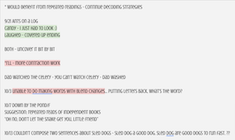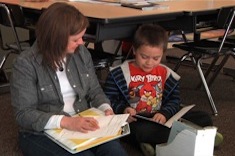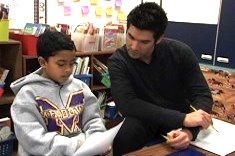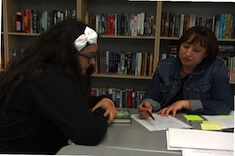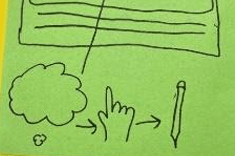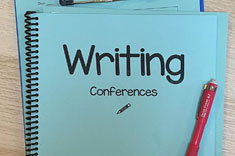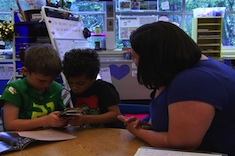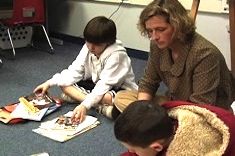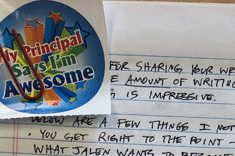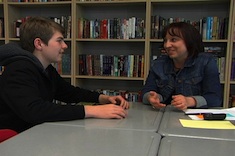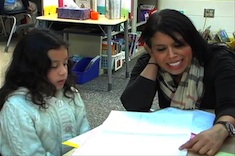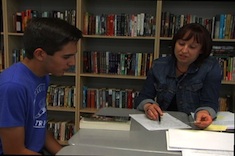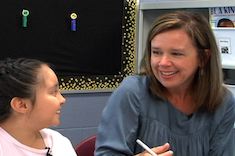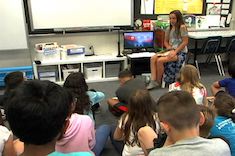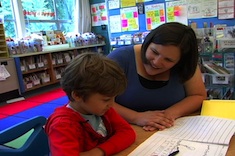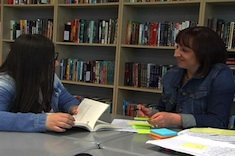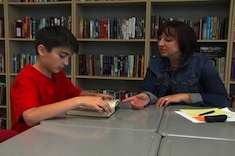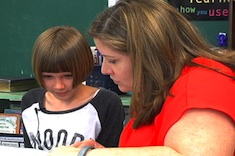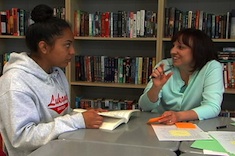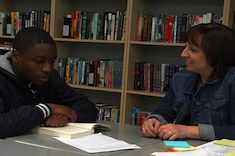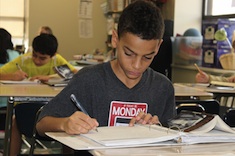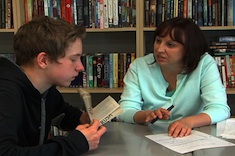Conferring
The teachable moment is what we live for - is there anything more magic than reaching a reader or writer with exactly the right words at exactly the right time? We've bottled some of that magic in the resources that follow, with print guidelines and scores of video examples from master teachers.
Latest Content
Creating a Teacher Notetaking System
Dana Murphy, a reading specialist, guides all teachers in ways to develop a notetaking system that works perfectly because it is personalized.
Conferring Notebook Details
Bitsy Parks opens her conferring notebook and shares powerful ways to use conferring notes to differentiate instruction for students in reading and writing.
What Should I Teach in a Writing Conference?
Tara Barnett and Kate Mills guide us in determining what to teach in a writing conference. Included is a template to use for conference notes.
Conferring Over Character Motivation
Christy Rush-Levine confers with Erica about her reading response to 13th Reality. She helps Erica consider character motivation.
Making Feedback Visible for Young Writers
Ruth Metcalfe is determined to make teaching points from writing conferences visible for her young multi-language learners. She offers a how-to guide for all teachers to do the same and make the teaching accessible to students even after the conference is over.
Giving Feedback to Energize Writers
Josie Stewart and Hannah Tills ponder the importance of energizing writers with feedback. They offer tips to ensure feedback uplifts writers.
A Three-Part Conferring Kit
Bitsy Parks shares a simple three-part conferring kit that will position anecdotal notes to guide instruction.
Conferring Over Whole-Class Reading
Deb Gaby confers with Riley about The Lemonade War. They talk about the writing about reading that students are doing for this whole-class read.
A Roving Student Conferrer
Tammy Mulligan encourages students to support their peers as writers by being a “roving student conferrer.” When we enable students to take on the role of the teacher, it helps solidify what they know, as well as take pride in their writing skills.
Sincerely Positive
Matt Renwick offers advice on how to use feedback as a tool to support and reinforce what students are doing well. Sincerity and positivity will always give students more confidence in themselves as writers.
Reading Conference: Sports Connections
Christy Rush-Levine confers with Carson about his connections to sports in his reading.
First-Grade Conference: Information Writing
Stella Villalba confers with Esmeralda about her information writing on blue jays.
Conferring over Motivation and Genre
Christy Rush-Levine confers with Griffin over his reading responses. They consider the differences between dystopian literature and realistic fiction, as well as what motivates characters.
Balancing Conferences and Small Groups
Balancing small groups and conferences is essential for transferring learning from lessons and units, and it’s one of the trickiest tasks for teachers. Dana Murphy explains how she works toward balance in her classroom, weighing everything from the timeline of the unit to the intensity of the minilesson.
Writing Partner Feedback in Fifth Grade
Fifth-grade writers in Franki Sibberson’s classroom encourage each other and suggest revisions to their opinion-writing drafts in partner teams.
Big Table Writing
Max Brand uses the “big table” in his kindergarten classroom as a communal spot for writing. You can see how he interrupts students naturally to make quick suggestions, and allows some interruptions of his own writing as he works with his students.
Digital and Disney: Conferring with Ben
It would be easy to zip quickly through a writing conference about a vacation story, especially one about a trip to Disney. In this video, Franki Sibberson slows down with Ben to explore how he is meeting his goal of adding descriptive language to writing, using digital tools to assist.
Student-Led Minilesson: Annotating Reading with Sticky Notes
Students can claim who they are as readers and writers by designing and presenting minilessons to their peers. In this week’s video, fifth grader Reagan from Franki Sibberson’s classroom presents a lesson on annotating reading with sticky notes.
Crafting the Basics: First-Grade Writing Conference
Bitsy Parks confers with Aubrey early in the year, using books from whole-class lessons as a scaffold for understanding key text elements like title, author, and illustrations.
First-Grade Writing Conference: Celebrations to Suggestions
Katrina Edwards begins her conference with first grader Allen by celebrating all he is doing well in his writing. She highlights his language and details in writing before moving on to new strategies to try.
Linking Pictures and Text: Conferring with Ava
Katrina Edwards begins her conference with first grader Ava by having her share what she learned from a picture walk through a simple text, and then she helps her use pictures to decode text while reading.
Cause and Effect: Conferring with Olivia
Christy Rush-Levine confers with Olivia about the principle of cause and effect in the novel she is reading.
History Through a Child’s Eyes: Conferring with Omar
Christy Rush-Levine confers with Omar, who is reading The Rock and the River. The book is a fictional account of a tumultuous time in civil rights history, considering protests through a child’s eyes.
A Poem About Lost Friendship: Conferring with Estelle
Estelle shares a poem she has written about lost friendship with her teacher, Katherine Sokolowski. She captures the fickle nature of fifth-grade relationships among girls. Katherine connects the cadence of the writing to the style of The Crossover, and helps Estelle find possibilities for more writing.
Reading Conference: Keeping Track of Characters
Christy Ruth-Levine confers with Edith, who is tracking character changes in the novel Room.
From Title to Theme: Conferring with Jadev
Christy Rush-Levine confers with Jadev about how the title of a book often gives clues to its theme.
Writing Routines: Drafting Autonomy
Justin Stygles questions his conferring routine during writing workshops, and the value of interrupting students early in the drafting process.
Understanding War: Conferring with Cam
Christy Rush-Levine confers with Cam, an eighth grader who seeks to understand the complexity of war through the experiences of main characters in novels.
Conference Records That Stay with Kids
Ruth Ayres explains why conferring records that stay with kids are useful for teachers.
Browse Content By
Type
Category
- Assessment Tools
- Big Fresh Archives
- Booklists
- Choice Numeracy
- Classroom Design
- Common Core
- Community Building
- Conferring
- Content Literacy
- Digital Literacy
- English Language Learners
- Equity
- Family Relations
- Free Samples
- Guiding Groups
- Leadership
- Literacy Coaches
- Mentor Texts
- Minilessons
- New Teacher Mentors
- Podcasts
- Poetry
- Quote Collections
- Reading Strategies
- Self Care
- Struggling and Striving Learners
- Talking and Listening
- Teacher Study Groups
- Teaching Reading
- Teaching Writing
- Word Study and Vocabulary
Author
- Melissa Quimby
- Nawal Qarooni
- Gwen Blumberg
- Julie Cox
- The Lead Learners
- Hannah Tills
- Josie Stewart
- Ruth Metcalfe
- Mallory Messenger
- Becca Burk
- Jodie Bailey
- Vivian Chen
- Mary Brower
- Tiffany Abbott Fuller
- Stephanie Affinito
- Ruth Ayres
- Leigh Anne Eck
- Heather Fisher
- Shari Frost
- Julie Johnson
- Suzy Kaback
- Gigi McAllister
- Shirl McPhillips
- Melanie Meehan
- Cathy Mere
- Debbie Miller
- Tara Barnett and Kate Mills
- Tammy Mulligan
- Dana Murphy
- Bitsy Parks
- David Pittman
- Brenda Power
- Heather Rader
- Matt Renwick
- Mandy Robek
- Christy Rush-Levine
- Gretchen Schroeder
- Jen Schwanke
- Brian Sepe
- Katherine Sokolowski
- Stella Villalba
- Jennifer Vincent
Grade Level
Choice Literacy Membership
Articles
Get full access to all Choice Literacy article content
Videos
Get full access to all Choice Literacy video content
Courses
Access Choice Literacy course curriculum and training

